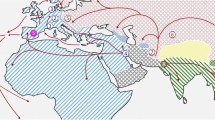Abstract
The rapid evolution1 and maternal mode of inheritance2 of mitochondrial DNA (mtDNA) make it a valuable marker for individuals related by descent from the same female3. We report here a study of wild and inbred mice which illustrates this point. We have examined mouse mtDNA from various locales in the Northern Hemisphere using restriction enzymes that cut the molecule at an average of 150 sites and find a high level of restriction-site polymorphism in wild mice but no variation among the ‘old’ inbred strains. This result is surprising because the nuclear genomes of these strains are known to differ greatly from one another4. The old inbred type of mtDNA occurs rarely in wild mice and differs from other types in the wild by an average of 100 nucleotide substitutions. In possible contradiction of published breeding records, these findings indicate that only one female lineage contributed to the formation of all the old inbred lines. In addition, our study of new inbred strains provides genetic markers that will be useful in mouse developmental and cell biology.
Similar content being viewed by others
References
Brown, W. M., George, M. & Wilson, A. C. Proc. natn. Acad. Sci. U.S.A. 76, 1967–1971 (1979).
Giles, R. E., Blanc, H., Cann, H. M. & Wallace, D. C. Proc. natn. Acad. Sci. U.S.A. 77, 6715–6719 (1980).
Brown, W. M. & Wright, J. W. Science 203, 1247–1249 (1979).
Staats, J. Cancer Res. 40, 2083–2128 (1980).
Marshall, J. T. & Sage, R. D. in Biology of the House Mouse (ed. Berry, R. J.) 15–25 (Academic, London, 1981).
Sage, R. D. in The Mouse in Biomedical Research Vol. 1 (eds Foster, H. L., Small, J. D. & Fox, J. G.) 39–90 (Academic, New York, 1981).
Ferris, S. D., Sage, R. D. & Wilson, A. C. Genetics (in the press).
Forejt, J. & Iványi, P. Genet. Res. 24, 189–206 (1974).
Nei, M. & Li, W.-H. Proc. natn. Acad. Sci. U.S.A. 76, 5269–5273 (1979).
Bibb, M. J., Van Etten, R. A., Wright, C. T., Walberg, M. W. & Clayton, D. A. Cell 26, 167–180 (1981).
Upholt, W. B. & Dawid, I. B. Cell 11, 571–583 (1977).
Avise, J. C., Lansman, R. A. & Shade, R. O. Genetics 92, 279–295 (1979).
Avise, J. C., Giblin-Davidson, C., Laerm, J., Patton, J. C. & Lansman, R. A. Proc. natn. Acad. Sci. U.S.A. 76, 6694–6698 (1979).
Brown, G. G. & Simpson, M. V. Genetics 97, 125–143 (1981).
Ferris, S. D., Brown, W. M., Davidson, W. S. & Wilson, A. C. Proc. natn. Acad. Sci U.S.A. 78, 6319–6323 (1981).
Yonekawa, H. et al. Genetics (in the press).
Yonekawa, H. et al. Jap. J. Genet. 55, 289–296 (1980).
King, B., Shade, R. O. & Lansman, R. A. Plasmid 5, 313–328 (1981).
Sage, R. D. in Origins of Inbred Mice (ed. Morse, H. C. III) 519–553 (Academic, New York, 1978).
Berry, R. J., Sage, R. D., Lidicker, W. Z. & Jackson, W. B. J. Zool. 193, 391–404 (1981).
Nadeau, J. H., Wakeland, E. K., Götze, D. & Klein, J. Genet. Res. 37, 17–31 (1981).
Morse, H. C. III in Origins of Inbred Mice (ed. Morse, H. C. III) 3–21 (Academic, New York, 1978).
Keeler, C. E. The Laboratory Mouse. Its Origin, Heredity, and Culture (Harvard University Press, Cambridge, 1931).
Lynch, C. J. Lab. Anim. Care 19, 214–220 (1969).
Festing, M. F. W. Inbred Strains in Biomedical Research (Oxford University Press, New York, 1979).
Hunt, W. G. & Seiander, R. K. Heredity 31, 11–33 (1973).
Brown, W. M. Proc. natn. Acad. Sci. U.S.A. 77, 3605–3609 (1980).
Thaler, L., Bonhomme, F. & Britton-Davidian, J. in Biology of the House Mouse (ed. Berry, R. J.) 27–41 (Academic, London, 1981).
Author information
Authors and Affiliations
Rights and permissions
About this article
Cite this article
Ferris, S., Sage, R. & Wilson, A. Evidence from mtDNA sequences that common laboratory strains of inbred mice are descended from a single female. Nature 295, 163–165 (1982). https://doi.org/10.1038/295163a0
Received:
Accepted:
Issue Date:
DOI: https://doi.org/10.1038/295163a0
- Springer Nature Limited
This article is cited by
-
Whole exome sequencing of wild-derived inbred strains of mice improves power to link phenotype and genotype
Mammalian Genome (2017)
-
Darcin: a male pheromone that stimulates female memory and sexual attraction to an individual male's odour
BMC Biology (2010)
-
Multigenic factors associated with a hydrocephalus-like phenotype found in inter-subspecific consomic mouse strains
Mammalian Genome (2008)
-
On the subspecific origin of the laboratory mouse
Nature Genetics (2007)
-
Strategies for mapping and cloning quantitative trait genes in rodents
Nature Reviews Genetics (2005)





